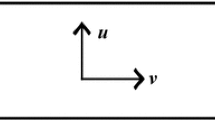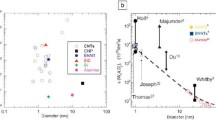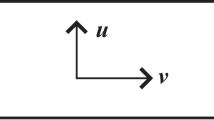Abstract
The mechanical coupling between the carbon nanotube (CNT) and the inner streaming water flow is investigated using non-equilibrium molecular dynamics simulations. A strong coupling is found at a critical streaming velocity and such coupling results in the local buckling of single-walled or multi-walled CNTs. The flow-excited radial resonance and the drastic energy exchange-induced radial deformation amplification of the tube contribute to the occurrence of buckling. The tube instability in turn gives rise to the unstable water transport. In contrast to instability occurrence of lamped–lamped macropipes conveying fluid, fully fixing tube’s boundary atoms may eliminate such instability. Combined with the finite element analysis, the effects of the tube size, hydrostatic pressure, van der Waals interaction strength, and the tube wall number on the buckling are discussed. The unusual result is that increasing the hydrostatic pressure weakens the tube’s stability.







Similar content being viewed by others
References
Barrat J-L (1999) Influence of wetting properties on hydrodynamic boundary conditions at a fluid/solid interface. Faraday Discuss 112:119–128
Brenner DW, Shenderova OA, Harrison JA, Stuart SJ, Ni B, Sinnott SB (2002) A second-generation reactive empirical bond order (REBO) potential energy expression for hydrocarbons. J Phys-Condens Matter 14(4):783–802. doi:10.1088/0953-8984/14/4/312
Chen HB, Johnson JK, Sholl DS (2006) Transport diffusion of gases is rapid in flexible carbon nanotubes. J Phys Chem B 110(5):1971–1975. doi:10.1021/Jp056911i
Chen X, Cao GX, Han AJ, Punyamurtula VK, Liu L, Culligan PJ, Kim T, Qiao Y (2008) Nanoscale fluid transport: size and rate effects. Nano Lett 8(9):2988–2992. doi:10.1021/Nl802046b
Chen C, Ma M, Jin K, Liu JZ, Shen LM, Zheng QS, Xu ZP (2011) Nanoscale fluid-structure interaction: flow resistance and energy transfer between water and carbon nanotubes. Phys Rev E 84(4):046314. doi:10.1103/Physreve.84.046314
Duan WH, Wang Q (2010) Water transport with a carbon nanotube pump. ACS Nano 4(4):2338–2344. doi:10.1021/Nn1001694
Falk K, Sedlmeier F, Joly L, Netz RR, Bocquet L (2010) Molecular origin of fast water transport in carbon nanotube membranes: superlubricity versus curvature dependent friction. Nano Lett 10(10):4067–4073. doi:10.1021/Nl1021046
Ghosh S, Sood AK, Kumar N (2003) Carbon nanotube flow sensors. Science 299(5609):1042–1044. doi:10.1126/science.1079080
Huang DM, Sendner C, Horinek D, Netz RR, Bocquet L (2008) Water slippage versus Contact angle: a quasiuniversal relationship. Phys Rev Lett 101(22):226101. doi:10.1103/Physrevlett.101.226101
Hummer G, Rasaiah JC, Noworyta JP (2001) Water conduction through the hydrophobic channel of a carbon nanotube. Nature 414(6860):188–190. doi:10.1038/35102535
Humplik T, Lee J, O’Hern SC, Fellman BA, Baig MA, Hassan SF, Atieh MA, Rahman F, Laoui T, Karnik R, Wang EN (2011) Nanostructured materials for water desalination. Nanotechnology 22(29):292001. doi:10.1088/0957-4484/22/29/292001
Insepov Z, Wolf D, Hassanein A (2006) Nanopumping using carbon nanotubes. Nano Lett 6(9):1893–1895. doi:10.1021/Nl060932m
Joseph S, Aluru NR (2008) Why are carbon nanotubes fast transporters of water? Nano Lett 8(2):452–458. doi:10.1021/Nl072385q
Koga K, Gao GT, Tanaka H, Zeng XC (2001) Formation of ordered ice nanotubes inside carbon nanotubes. Nature 412(6849):802–805. doi:10.1038/35090532
Kuang Y, Shi S, Chan P, Chen C (2010) The effect of intertube van der Waals interaction on the stability of pristine and functionalized carbon nanotubes under compression. Nanotechnology 21(12):125704
Longhurst MJ, Quirke N (2007) Pressure dependence of the radial breathing mode of carbon nanotubes: the effect of fluid adsorption. Phys Rev Lett 98(14):145503. doi:10.1103/Physrevlett.98.145503
Majumder M, Chopra N, Andrews R, Hinds BJ (2005) Nanoscale hydrodynamics—enhanced flow in carbon nanotubes. Nature 438(7064):44. doi:10.1038/43844a
Maniwa Y, Matsuda K, Kyakuno H, Ogasawara S, Hibi T, Kadowaki H, Suzuki S, Achiba Y, Kataura H (2007) Water-filled single-wall carbon nanotubes as molecular nanovalves. Nat Mater 6(2):135–141. doi:10.1038/Nmat1823
Nanok T, Artrith N, Pantu P, Bopp PA, Limtrakul J (2009) Structure and dynamics of water confined in single-wall nanotubes. J Phys Chem A 113(10):2103–2108. doi:10.1021/Jp8088676
Ni B, Sinnott SB, Mikulski PT, Harrison JA (2002) Compression of carbon nanotubes filled with C 60, CH 4, or Ne: predictions from molecular dynamics simulations. Phys Rev Lett 88(20):205505
Paidoussis M, Denise J-P (1972) Flutter of thin cylindrical shells conveying fluid. J Sound Vib 20(1):9–26
Plimpton S (1995) Fast parallel algorithms for short-range molecular-dynamics. J Comput Phys 117(1):1–19. doi:10.1006/jcph.1995.1039
Qin LC, Zhao XL, Hirahara K, Miyamoto Y, Ando Y, Iijima S (2000) Materials science—the smallest carbon nanotube. Nature 408(6808):50. doi:10.1038/35040699
Qin X, Yuan Q, Zhao Y, Xie S, Liu Z (2011) Measurement of the rate of water translocation through carbon nanotubes. Nano Lett 11(5):2173–2177
Sholl DS, Johnson JK (2006) Making high-flux membranes with carbon nanotubes. Science 312(5776):1003–1004. doi:10.1126/science.1127261
Striolo A (2006) The mechanism of water diffusion in narrow carbon nanotubes. Nano Lett 6(4):633–639. doi:10.1021/Nl052254u
Thomas JA, McGaughey AJ (2009) Water flow in carbon nanotubes: transition to subcontinuum transport. Phys Rev Lett 102(18):184502
Thomas JA, McGaughey AJ, Kuter-Arnebeck O (2010) Pressure-driven water flow through carbon nanotubes: insights from molecular dynamics simulation. Int J Therm Sci 49(2):281–289
Walther JH, Ritos K, Cruz-Chu ER, Megaridis CM, Koumoutsakos P (2013) Barriers to superfast water transport in carbon nanotube membranes. Nano Lett 13(5):1910–1914. doi:10.1021/Nl304000k
Wang JB, Guo X, Zhang HW, Wang L, Liao JB (2006) Energy and mechanical properties of single-walled carbon nanotubes predicted using the higher order Cauchy-Born rule. Phys Rev B 73(11):115428. doi:10.1103/Physrevb.73.115428
Xiao T, Liao K (2002) Nonlinear elastic properties of carbon nanotubes subjected to large axial deformations. Phys Rev B 66(15):153407. doi:10.1103/Physrevb.66.153407
Yakobson BI, Brabec CJ, Bernholc J (1996) Nanomechanics of carbon tubes: instabilities beyond linear response. Phys Rev Lett 76(14):2511–2514. doi:10.1103/PhysRevLett.76.2511
Yan Y, He X, Zhang L, Wang Q (2007) Flow-induced instability of double-walled carbon nanotubes based on an elastic shell model. J Appl Phys 102(4):044307
Acknowledgments
This work is supported by grants from the Research Grants Council of Hong Kong (B-Q19A and E-RD39).
Author information
Authors and Affiliations
Corresponding author
Rights and permissions
About this article
Cite this article
Kuang, Y.D., Shi, S.Q. Strong mechanical coupling between the carbon nanotube and the inner streaming water flow. Microfluid Nanofluid 17, 1053–1060 (2014). https://doi.org/10.1007/s10404-014-1391-1
Received:
Accepted:
Published:
Issue Date:
DOI: https://doi.org/10.1007/s10404-014-1391-1




